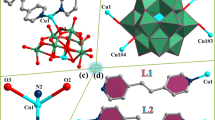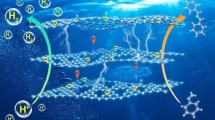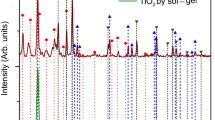Abstract
In this work we examine the benefits of using carefully designed tri-component composites to fabricate flexible photocathode electrodes for photo-electrocatalytic hydrogen (H2) generation from neutral pH water. We report H2 production by a tri-component composite thin-film containing CuO nanowires (CuO NW), reduced graphene oxide (rGO) and polypyrrole (PPy). At − 1.1 V vs Ag/AgCl in 0.5 M Na2SO4 (pH 6.8) with a hole-scavenger, under weak light illumination, he photocurrent performance was fivefold greater than the bi-component CuO–rGO control having the same absolute quantities of CuO and rGO. It was 30-fold greater than the CuO–PPy control. The tri-component CuO–rGO–PPy thin film therefore displayed an active H2-generating capacity compare with its bi-component analogues. It, effectively, exploited the advantages of each component, including the suppression of charge recombination afforded by the rGO, and the photocorrosion protection, immobilization and flexibility afforded by the PPy, whilst avoiding their disadvantages.
Graphic Abstract
Entry for the Table of contents






Similar content being viewed by others
References
Bhatt MD, Lee JS (2015) Recent theoretical progress in the development of photoanode materials for solar water splitting photoelectrochemical cells. J Mater Chem A 3(20):10632–10659
Al-Keisy A, Mahdi R, Ahmed D, Al-Attafi K, Abd. Majid WHJC (2020) Enhanced photoreduction activity in BiOI1-xFx nanosheet for efficient removal of pollutants from aqueous solution. ChemistrySelect 5(31):9758–64
Ibrahem MA, Rasheed BG, Mahdi RI, Khazal TM, Omar MM, O’Neill MJRA (2020) Plasmonic-enhanced photocatalysis reactions using gold nanostructured films. RSC Adv 10(38):22324–22330
Haider AJ, Jameel ZN, Al-Hussaini IHM (2019) Review on: titanium dioxide applications. Energy Procedia 157:17–29
Zhang Y, Heo Y-J, Lee J-W et al (2018) Photocatalytic hydrogen evolution via water splitting: a short review. Catalysts 8(12):655
Li J, Pan Z, Zhou KJN (2018) Enhanced photocatalytic oxygen evolution activity by formation of Ir@ IrOx(OH)y core–shell heterostructure. Nanotechnology 29(40):405705
Li Y, Peng Y-K, Hu L et al (2019) Photocatalytic water splitting by N-TiO2 on MgO (111) with exceptional quantum efficiencies at elevated temperatures. Nat Commun 10(1):1–9
Nanda S, Rana R, Zheng Y, Kozinski JA, Dalai AK (2017) Insights on pathways for hydrogen generation from ethanol. Sustain Energy Fuels 1(6):1232–1245
Liao C-H, Huang C-W, Wu JCS (2012) Hydrogen production from semiconductor-based photocatalysis via water splitting. Catalysts 2(4):490–516
Qi J, Zhang W, Cao R (2018) Solar-to-hydrogen energy conversion based on water splitting. Adv Energy Mater 8(5):1701620
Xing H, Lei E, Guo Z, Zhao D, Li X, Liu Z (2019) Exposing the photocorrosion mechanism and control strategies of a CuO photocathode. Inorg Chem Front 6(9):2488–2499
Chang B, Yang Y, Ye Z, Liu S (2019) Enhancement of alkaline water splitting activity by Co–P coating on a copper oxide nanowire. Dalton Trans 48(3):891–897
Yang Y, Xu D, Wu Q, Diao P (2016) Cu2O/CuO bilayered composite as a high-efficiency photocathode for photoelectrochemical hydrogen evolution reaction. Sci Rep 6(1):35158
Zhao X, Wang P, Yan Z, Ren N (2014) Ag nanoparticles decorated CuO nanowire arrays for efficient plasmon enhanced photoelectrochemical water splitting. Chem Phys Lett 609:59–64
Wang X, Cho HJ (2018) p-CuO nanowire/n-ZnO nanosheet heterojunction-based near-UV sensor fabricated by electroplating and thermal oxidation process. Mater Lett 223:170–173
Yang J, Liang Y, Li K et al (2017) Design of 3D flowerlike BiOClxBr1–x nanostructure with high surface area for visible light photocatalytic activities. J Alloy Compd 725:1144–1157
Xu Y, Jian J, Li F, Liu W, Jia L, Wang H (2019) Porous CuBi2O4 photocathodes with rationally engineered morphology and composition towards high-efficiency photoelectrochemical performance. J Mater Chem A 7(38):21997–22004
Wang Z, Wang L (2018) Photoelectrode for water splitting: materials, fabrication and characterization. Sci China Mater 61(6):806–821
Zhang W, Huo S, Yang S et al (2019) Ternary monolithic ZnS/CdS/rGO photomembrane with desirable charge separation/transfer routes for effective photocatalytic and photoelectrochemical hydrogen generation. Chem Asian J 14(19):3431–41
Basu M (2019) Porous cupric oxide: efficient photocathode for photoelectrochemical water splitting. ChemPhotoChem 3(12):1254–1262
Nahor O, Segal-Peretz T, Neeman L, Oron D, Frey GL (2014) Controlling morphology and charge transfer in ZnO/polythiophene photovoltaic films. J Mater Chem C 2(21):4167–4176
Tran-Thi T-H, Dagnelie R, Crunaire S, Nicole L (2011) Optical chemical sensors based on hybrid organic–inorganic sol–gel nanoreactors. Chem Soc Rev 40(2):621–639
Yang J, Wang X, Li B et al (2017) Novel iron/cobalt-containing polypyrrole hydrogel-derived trifunctional electrocatalyst for self-powered overall water splitting. Adv Funct Mater 27(17):1606497
Li J-S, Wang Y, Liu C-H et al (2016) Coupled molybdenum carbide and reduced graphene oxide electrocatalysts for efficient hydrogen evolution. Nat Commun 7(1):11204
Steier L, Bellani S, Rojas HC et al (2017) Stabilizing organic photocathodes by low-temperature atomic layer deposition of TiO2. Sustain Energy Fuels 1(9):1915–1920
do Amaral Carminati S, Souza FL, Nogueira AF (2016) Enhancing hematite photoanode activity for water oxidation by incorporation of reduced graphene oxide. ChemPhysChem 17(1):170–177
Wang M, Shang X, Yu X et al (2014) Graphene–CdS quantum dots–polyoxometalate composite films for efficient photoelectrochemical water splitting and pollutant degradation. Phys Chem Chem Phys 16(47):26016–26023
Dubey PK, Tripathi P, Tiwari RS, Sinha ASK, Srivastava ON (2014) Synthesis of reduced graphene oxide–TiO2 nanoparticle composite systems and its application in hydrogen production. Int J Hydrog Energy 39(29):16282–16292
Khan I, Ibrahim AAM, Sohail M, Qurashi A (2017) Sonochemical assisted synthesis of RGO/ZnO nanowire arrays for photoelectrochemical water splitting. Ultrason Sonochem 37:669–675
Alsultan M, Choi J, Jalili R, Wagner P, Swiegers GF (2018) Synergistic amplification of catalytic hydrogen generation by a thin-film conducting polymer composite. Catal Sci Technol 8(16):4169–4179
Momeni MM, Ghayeb Y, Menati M (2018) Fabrication, characterization and photoelectrochemical properties of cuprous oxide-reduced graphene oxide photocatalysts for hydrogen generation. J Mater Sci Mater Electron 29(5):4136–4146
Tran PD, Batabyal SK, Pramana SS, Barber J, Wong LH, Loo SCJ (2012) A cuprous oxide–reduced graphene oxide (Cu2O–rGO) composite photocatalyst for hydrogen generation: employing rGO as an electron acceptor to enhance the photocatalytic activity and stability of Cu2O. Nanoscale 4(13):3875–3878
Zhang Q, Huang L, Kang S et al (2017) CuO/Cu2O nanowire arrays grafted by reduced graphene oxide: synthesis, characterization, and application in photocatalytic reduction of CO2. RSC Adv 7(69):43642–43647
Fan X, Yang Z, He N (2015) Hierarchical nanostructured polypyrrole/graphene composites as supercapacitor electrode. RSC Adv 5(20):15096–15102
Sun R, Chen H, Li Q, Song Q, Zhang X (2014) Spontaneous assembly of strong and conductive graphene/polypyrrole hybrid aerogels for energy storage. Nanoscale 6(21):12912–12920
Chougule M, Pawar S, Godse P et al (2011) Synthesis and characterization of polypyrrole (PPy) thin films. Soft Nanosci Lett 1(1):6–10
Dubal DP, Gund GS, Lokhande CD, Holze R (2013) CuO cauliflowers for supercapacitor application: novel potentiodynamic deposition. Mater Res Bull 48(2):923–928
Radhakrishnan A, Rejani P, Beena B (2015) CuO/polypyrrole nanocomposites as a marker of toxic lead ions for ecological remediation in contrast with CuO and polypyrrole. Main Group Met Chem 38(5–6):133–143
Fan B, Guo H, Shi J et al (2016) Facile one-pot preparation of silver/reduced graphene oxide nanocomposite for cancer photodynamic and photothermal therapy. J Nanosci Nanotechnol 16:7049–7054
Acknowledgements
This work was supported by, and the authors acknowledge the services provided by the Iraq Ministry of Higher Education and Scientific Research. The authors acknowledge the Australian National Fabrication Facility (ANFF) Materials Node for equipment use. Support from the Australian Research Council Centre of Excellence Scheme (Project Number CE140100012) is gratefully acknowledged. The authors acknowledge use of facilities and the assistance of Tony Romeo within the University of Wollongong Electron Microscopy Centre. This research used equipment funded by the Australian Research Council (ARC)—Linkage, Infrastructure, Equipment and Facilities (LIEF) Grant LE160100063 located at the University of Wollongong Electron Microscopy Centre.
Author information
Authors and Affiliations
Corresponding authors
Ethics declarations
Conflict of interest
The authors declare that they have no conflict of interest.
Additional information
Publisher's Note
Springer Nature remains neutral with regard to jurisdictional claims in published maps and institutional affiliations.
Electronic supplementary material
Below is the link to the electronic supplementary material.
Supplementary file2 (MP4 6295 kb)
Rights and permissions
About this article
Cite this article
Mahdi, R., Alsultan, M., Al-Keisy, A. et al. Photocatalytic Hydrogen Generation from pH-Neutral Water by a Flexible Tri-Component Composite. Catal Lett 151, 1700–1706 (2021). https://doi.org/10.1007/s10562-020-03427-1
Received:
Accepted:
Published:
Issue Date:
DOI: https://doi.org/10.1007/s10562-020-03427-1




